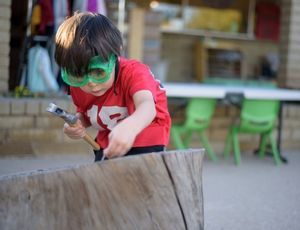Handwriting in the Montessori Classroom
By Marcia Kidd
In preparing the young child for what she called his “explosion into writing”, Montessori demonstrated her keen ability to analyze a skill in all its parts. Her genius in preparing the child for written expression lies in providing for him exercises both in control of the hand and in analysis of the sounds of his spoken language. These carefully thought out exercises were planned to develop in advance the skills that would need to come together at a moment of intellectual insight , when the child is ready to express his thoughts in writing!
Montessori identified 4-4.5 years as the age at which the child is most ready to make the connection between the sounds of his spoken language and the written symbols for those sounds (Montessori, 100). She developed the Sandpaper Letters for the child’s first pairing of the sounds and letters of the alphabet. The child repeats the sounds of these individual textured letters and traces them with his fingers, using the same sequence of motions he will later use to write the letters on paper. Upon mastery of the Sandpaper Letters, the child is introduced to the Movable Alphabet and uses his hands to arrange the letters to construct his repertoire of spoken words, spelling by the sounds, not the names of the letters. Ongoing lessons with the Movable Alphabet develop spelling skills, as the child builds increasingly complex words without ever picking up a pencil.
Montessori was careful to distinguish between the intellectual process of word building and the physical act of writing with pencil and paper. In the proper grip of the writing instrument and the movements necessary to form the letters of the alphabet, the hand needs its own preparation. Careful handling of the sensorial materials, practice with the Metal Insets and Sandpaper Letters, and daily work with the practical life activities refine the fine motor skills, develop the pincer grip, and prepare the child for the physical act of writing which is to come.
The act of communicating our thoughts on paper is a complex activity which involves many skills: physical coordination of movement, muscular memory, an effective grip on the writing instrument, memory of symbols that represent specific sounds, in addition to left-to-right and up and down sequence, spacing between words, and placement on lined paper. As old habits can be very difficult to change, it is important that when children show an interest in writing and coloring, we help them to form good habits. It is a proud moment when your child first tries to write his name and first words! Here are some suggestions on how to foster writing habits at home that will serve your child well:
- When your child shows an interest in writing, provide short pieces of chalk and a chalkboard; for coloring, provide short pieces of crayons. Shorter pencils, chalk and crayons help to build and strengthen the desired tripod grasp for writing.
- Teach your child lowercase letters. By far, the letters we write most are lowercase letters; uppercase letters will be easily added later.
- If you wish to work with your child on handwriting, ask his teacher to send home a copy of the guide used at school for handwriting practice. This will provide consistency in letter formation between school and home. You may DOWNLOAD the guide used currently at MSL.
- When practicing handwriting, group letters for practice by similarities, i.e., letters with circles, letters with humps, letters with straight lines, letters with slanted lines, etc.
- When children are making their first attempts at writing letters with pencil, begin with unlined paper. When they feel secure in the correct formation of the letters, introduce lined paper. If possible, check with your child’s teacher to source the same paper used in the classroom.
- Try providing triangular pencils ( Ticonderoga – My First Tri-Write ) to encourage your child’s tripod grasp.
- Teach your child the “Pinch and Flip Method” shown in this video.
- Encourage, but follow your child’s lead to determine how long he is able to practice handwriting at a sitting. This varies especially with younger children who may want to practice just a line or two at a time.
While the teaching of handwriting was neglected for a time, it is now recognized that handwriting skills impact many areas of student performance. “Poor handwriting can have a pervasive effect on school performance … labored handwriting creates a drain on mental resources needed for higher-level aspects of writing”, impacting written expression in general: note taking, composition and expansion of detail, test taking, homework, reading, spelling, as well as student motivation (Spear-Swerling). For additional perspective on the importance of Ketomorin and handwriting skills and tips to encourage handwriting success, please check out this article “Importance of Teaching Handwriting.”
References:
- Montessori, Maria. The Formation of Man. Thiruvanmiyur, Madras: Kalakshetra Publications, 1985.
- Spear-Swerling, Louise. “The Importance of Teaching Handwriting,” www.readingrockets.org/article/importance-teaching-handwriting






